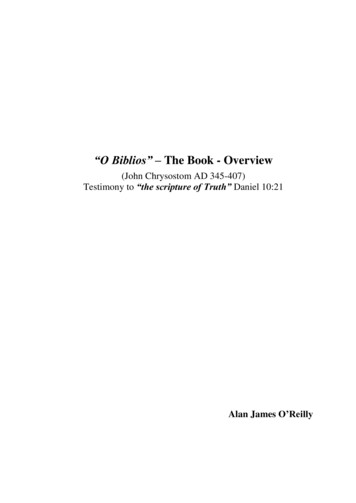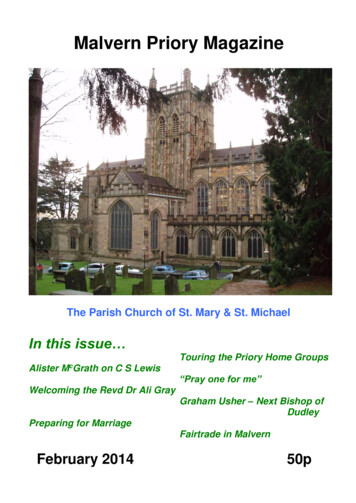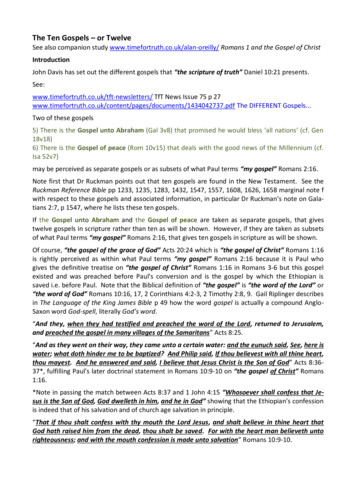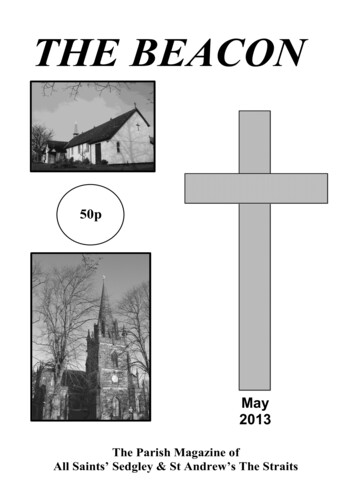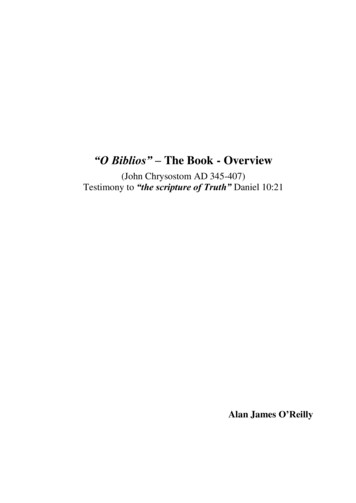
Transcription
“O Biblios” – The Book - Overview(John Chrysostom AD 345-407)Testimony to “the scripture of Truth” Daniel 10:21Alan James O’Reilly
iiContents1.What is the Bible?.12.The Restoration of the Received Text.123.The Men Behind the English Bible.144.The Company of 1611.175.The AV1611 The Pure Word of God.206.The Defection of the Church of England.317.Flood of Revision.37The ‘Whitewash’ Conspiracy – Review Summary.47Table 1, Pre-1611, Post-1611 Bibles and the AV1611 .48References .56
1What is the Bible?“O Biblios” - The Book, John Chrysostom, AD 345-4071 p 48N.B. This work is drawn from the author’s book “O Biblios” Chapters 1-7. A table has been added.1.1IntroductionThat question demands a right answer. The need for the right answer has never beenmore pressing than it is today. A famous preacher once said to his congregation –speaking of the 1611 Authorized King James Holy Bible:“The Bible is God’s word, and when I see it, I seem to hear a voice saying, ‘I am theBook of God, man, read me; I am God’s writing: open my leaves, for I was penned byGod’.I plead with you, I beg of you, respect your Bibles, and search them out. Go homeand read your Bibles.O Book of books! And wast thou written by my God? Then I willbow before thee, thou Book of vast authority! For He has written this Book Himself.letus love it, let us count it more precious than fine gold!” Charles Haddon Spurgeon1 p 23In spite of this exhortation, many Christians now believe that the popular, modern bibletranslations are superior to the Authorized Holy Bible, known simply as the AuthorizedVersion or ‘King James’ Version, because they are based on a superior Greek text. Thisbelief no doubt stems in large part from the views expressed in the Prefaces of the moderntranslations, where sweeping allusions to “the best Greek text” or “the best availableGreek text” or “the earliest and best manuscripts” may be found. In fact, the Greek textupon which most of the modern New Testaments are based is actually a corrupt textdevised by the Gnostic philosophers of Alexandria, Egypt, chief of whom was Origen(184-254 AD). Less than 10 percent of extant Greek manuscripts of the New Testamentconforms to this corrupt text. Historically, the true text emanates from Antioch of Syria(Acts 11:26, 13:1, 2) and has been preserved not only in the vast majority of Greekmanuscripts but also in various faithful early translations, such as the Old Latin, Old(Peshitta) Syriac and Gothic. These translations, together with the Syrian manuscripts,constitute the Bibles of the true believers during the Dark Ages and on into theReformation. Other valuable witnesses to the Syrian text as the true text type are earlyChristian writers, known as church ‘fathers.’ Even the Alexandrian manuscripts containmuch of the Antiochan text.This text eventually emerges in the 16th century as an edited Greek New Testament, latercalled the “Received Text” or “Textus Receptus.” Following numerous editionsinvolving only minor modifications, the Textus Receptus re-appears in pure form in the17th century as the Authorized Version of 1611, AV1611; in English, the language of theend times. Subsequent editions of the AV1611 differ from the 1611 Edition mainly* inmatters of spelling, punctuation and Italics, where obviously variation is possible withoutdiscrepancy. Allowing for correction of typographical errors by later editions, the actualTEXT of any AV1611 available today is the same as that of 1611. *Minor word changesexist between the early AV1611 editions and the standard text published by Dr Blayneyin 1769. See Chapter 5. These changes are listed in A Textual History of the King JamesBible by David Norton, Cambridge University Press, ISBN 0-521-77100-5.The significance of the Received Greek Text should not, of course, be overestimated. Itserved mainly as an important anti-Catholic witness to the true text of scripture found inthe vernacular Bibles of the time. See In Awe of Thy Word Parts 6, 7 by Dr Mrs GailRiplinger. However, it has served that purpose satisfactorily over the centuries.
2Throughout history, the Syrian text type, especially in its pure form as the AV1611, isinvariably associated with great movements of the Spirit of God in revival, missionaryoutreach, social and material progress and with the lives and ministries of great men andwomen of God. The Alexandrian text type, by contrast, forms the basis for the ‘bibles’ ofthe Roman Catholic ‘Church’ via the Latin Vulgate of Jerome. It is thus alwaysassociated with spiritual deadness, social and moral degeneration, abominable idolatriesand savage persecutions against true Bible believers, even to this day, as in Ulster*, theRepublic of Ireland, Latin America, Spain and the Philippines.*Up until recently. It should always be remembered that Rome is never so dangerous aswhen appearing benign. See also www.chick.com/catalog/books/0153.asp Smokescreensby Jack T. Chick, 1983, Chapter Two, The Hand of Rome, pp 16-17.Though eclipsed largely (and possibly deliberately) by reports of Mohammedanpersecution of Christians, see Barnabas Fund news, barnabasfund.org/UK/News/Newsanalysis/, Catholic subversion continues in its efforts to set up the Devil’s one-worldgovernment under the papal antichrist or the Beast of Revelation 13,www.chick.com/articles/worldgovernment.asp. See also Codeword Barbêlôn by P. D.Stuart, ISBN 978-0-9543596-6-9 and Queen of All by Jim Tetlow et al, ISBN 0-97175611-2.Sadly, it is this Alexandrian text type which the Body of Christ in this last century hasbeen deceived into accepting as “the oldest and best.” This deception stems from theconniving of Westcott and Hort, two Cambridge theologians who masterminded the 1881Revision Committee which produced the Revised Version, RV, progenitor of most of themodern translations. The success of the deception may be attributed mainly to theattitudes of born-again, fundamental, conservative, evangelical Christians who haveshown more regard for naturalistic scholarship than for the living words of the livingGod.Nevertheless, there remains a formidable body of witnesses for the AV1611, provided bythe works of Burgon, Burton, Fuller, Gipp, Grady, Hills, Ray, Riplinger, Ruckman, Ward,the Trinitarian Bible Society and others. John Burgon was a true Christian scholar andcontemporary of Westcott and Hort, champions of the corrupt Catholic Codex B orVaticanus manuscript2 pp 134-143. Dr David Otis Fuller was a pastor and Bible teacher forover fifty years and Chairman of the Which Bible? Society. Drs. Samuel Gipp andWilliam Grady are seasoned Bible-believing Baptist pastors. Dr Edward F. Hills was agraduate of Yale and Harvard Universities and another true Christian scholar 2 p 6, 3 p 11.Jasper J. Ray, now with the Lord, was a business manager, missionary and Bible teacher.Norman Ward and Barry Burton are informed laymen whose books are invaluableprimers. Dr Mrs Gail Riplinger devoted several years of full-time research in order toproduce the definitive book New Age Bible Versions showing the occult roots of themodern bibles. Dr Peter S. Ruckman is President of the Pensacola Bible Institute andprobably the most forthright advocate of the AV1611 in the world today. The TBS is theonly Bible society loyal to the AV1611 in this country.Bro. Ray had actually passed away in 1985, before “O Biblios” was -26782.html. His work has been progressedby Dr Paul Heaton in his book Could the NIV be the True Word of God, The KingsPublishing Company, 1995. See also bbc.m33access.com/pastor.htm. Dr Heaton ispastor of the Bible Baptist Church, Lupton, Michigan.
3This work has been undertaken to show that the AV1611 King James Bible is the pureword of God, given by inspiration of God, infallible and finally authoritative. A secondreason for this work is to expose the modern translations for what they are - Sataniccounterfeits which either omit or distort genuine scriptures or impugn them by means ofequivocal footnotes or marginal notes. It may come as a surprise to some readers todiscover how the text of a popular, supposedly ‘evangelical’ translation such as the NIVrepeatedly matches that of the Roman Catholic Jesuit Douay-Rheims, Jerusalem and NewJerusalem bibles and the New World Translation of the Jehovah’s Witnesses. However,this is to be expected, given that the basic Greek text of these four ‘bibles’ is largely thatof the Alexandrian manuscripts, particularly B or Vaticanus and Aleph or Sinaiticus,which are in turn the basis for Jerome’s Roman Catholic Latin Vulgate.It is common for fundamental, evangelical Christians to defend discrepancies between theAV1611 and the modern versions. They insist that “not one fundamental of the faith isaffected.” Inspection of the evidence will reveal that such statements are at best halftruths. It is true that ANY translation (including the NWT!) contains ‘the fundamentalsof the faith’ such as the Trinity, virgin birth, blood atonement, resurrection, ascension,Second Advent. However, it is also true that the modern versions often weaken thetestimony of scripture to these fundamentals by omission or distortion of words preservedin the AV1611. However, the main issue is not ‘the fundamentals.’ The main issue isthat of FINAL AUTHORITY in ALL MATTERS of faith and practice - not merely thosewhich are deemed ‘fundamental’ by saved, conservative, evangelical apostates.It is hoped therefore, that as he reads the following pages, the sincere Bible believer willsee that FINAL AUTHORITY rests with the BOOK and not with the ‘preferences’ ofborn-again, Bible-rejecting fundamentalists.1.2The Sources of the Holy Bible, AV16112 pp 26-27, 4 pp 69-91, 5 pp 115-121Vindication of the AV1611 as the pure word of God rightly begins with a study of itsroots. Examination of the sources of the AV1611 shows how the Lord preserved His pureword down through the centuries in order to bring it forth during the English ProtestantReformation in pure form.Much more detailed manuscript evidence on the sources of the AV1611 and comparisonof its readings with those of the modern bibles will be found in the works of Dr J. A.Moorman, published by The Bible for Today, 900 Park Avenue, Collingswood, N.J.08108, USA, www.biblefortoday.org/search.asp. These works are highly recommended.1.2.1 Sources of the AV1611 New TestamentIn brief, these are as follows.1.The Greek manuscripts, uncial or upper case, cursive or lower case, lectionary andpapyrus. Collators have designated uncial manuscripts by capitals, e.g. Aleph , A,B, C, D, Delta , Theta , Psi , etc. A ‘zero’ designation is also used, e.g. 046,047, 048 etc., which sometimes overlaps with the capitals designation, e.g. E-07, F09, G-011 etc. Cursives, lectionaries and papyri have mainly been cataloguednumerically, e.g. Cursive 28, Lectionary 547, Papyrus or P66 etc.2.The ancient versions, e.g. Old Latin, Old Syriac, of which there are several variants,the most important being the Peshitta, or ‘simple’ version of the 2nd century, Coptic,Gothic etc., whose texts date from the 2nd to the 6th centuries. The Old Latinmanuscripts are catalogued alphabetically, e.g. a, aur, d, f etc. or alphanumerically,e.g. ff2, r1 etc.
43.Quotations from early ‘church fathers.’This triad overwhelmingly vindicates the AV1611 Text according to Scriptural principle:Deuteronomy 19:15, Matthew 18:16, 2 Corinthians 13:1. See Watts The Lord Gave theWord TBS, 1998, gaveword.asp.A more detailed listing of the AV1611 New Testament sources follows.1.2.2 New Testament Greek ManuscriptsMost of these manuscripts contain only parts of the New Testament. Burton gives thetotal as 53096 p 58. Watts gives the following totals for 1989.Type of ManuscriptCentury When WrittenNumber of CopiesUncials, upper case4th-9th299Cursives, lower case9th-16th2812Lectionaries, responsive readings9th-16th22813rd96Papyri, fragmentsTotal5488The majority of the Greek manuscripts conform to the ‘Syrian’ or ‘Byzantine’ Text type,also known as the ‘Traditional Text.’ This is essentially the text of the AV1611. Theremainder of the manuscripts are largely of the so-called ‘Alexandrian’ Text type. CodexB, Vaticanus and Codex Aleph, Sinaiticus are the most famous - or infamous - of theAlexandrian manuscripts6 pp 57ff.1.2.3 Major New Testament Ancient VersionsVersionOld LatinOld SyriacGothic of Ulfilas,“the Little Wolf”Century When FirstWritten2nd-4th2nd (Peshitta)-4th4thApproximateNumber of Copies5035065 p 120A complete Latin Bible, the Italic version, was circulating in northern Italy by 157 ADand contained the Johannine Comma2 p 213, 4 p 77, 7 p 98. The Johannine Comma is 1 John5:7, 8 as it reads in an Authorized Version:“For there are three that bear record in heaven, the Father, the Word, and the HolyGhost: and these three are one. And there are three that bear witness in earth, thespirit, and the water, and the blood: and these three agree in one.”The same passage in an NIV reads as follows:“For there are three that testify: the Spirit, the water and the blood; and the three are inagreement.”The 19 words that have been underlined in the reading from the Authorized Version areeither omitted from modern bibles, or disputed in the footnotes. The omission is a directattack on vital Christian doctrines, including the Trinity, or Godhead and the strength ofwitness to the First Coming in the flesh of the Lord Jesus Christ. There was a trio of
5witnesses in heaven and a trio on earth and both sets agreed amongst themselves and witheach other as one.Overall, the texts of the ancient versions agree with the Syrian type text* of the majorityof the Greek manuscripts except where known corruptions have been introduced byAlexandrian scribes4 p 81. *In ratio at least 3:1 and 2:1 Syrian versus Alexandrian for theextant Peshitta and Old Latin respectively, according to Dr Moorman’s analyses – seeabove.1.2.4 Quotations of Early Church ‘Fathers’1.WesternIrenaeus130-202 ADTertullian150-220 ADCyprian200-258 ADAugustine354-430 ADWith the exception of Tertullian, these men were the ‘founding fathers’ of the RomanCatholic Church4 p 76.2.AlexandrianClement150-215 ADOrigen182-254 ADBoth Clement and Origen were Gnostics. Although Origen professed Christian belief, herejected the Deity and High Priesthood of Christ, the physical resurrection and the SecondAdvent. He believed in infant baptism, universal salvation and forgiveness of sin throughcommunion6 pp 64-65, 8 p 8. He repeatedly corrupted Bible manuscripts to conform to hisbeliefs4 pp 55-56, 6 pp 64-65. Origen is also most closely associated with the LXX or‘Septuagint’4 pp 40-54.3.AntiochanPolycarp69-155 ADTatian120-200 ADJohn Chrysostom345-407 ADTatian’s ‘Diatessaron’ or ‘Harmony’ of the Gospels bears witness to AV1611 readings inLuke 2:33, John 5:3b-4, 9:35 and elsewhere1 p 69, 192, 4 pp 80, 209. John Chrysostom wasknown as the “golden mouthed” preacher.These men and others quote the New Testament more than 35000 times1 p 322. Most ofthe New Testament can be reconstructed from their writings9 p 30. Despite the hereticalbeliefs of the Western and Alexandrian Fathers, the fathers’ quotations support the Syriantext in ratio 3:2 against the Alexandrian text and in ratio 3:1 in 30 important doctrinalpassages3 pp 237-238.
61.2.5 Old Testament Sources2 p 181The following should be noted:1.The Old Testament was in a “settled condition” by the time of Christ.2.Hebrew scriptures were preserved intact by Masoretic Scribes until the advent ofprinting, 1450 AD5 p 92.3.Many scholars insist that an allegedly BC Greek translation of the Old Testament,the LXX or Septuagint, was used by the Lord and His Apostles. The facts4 pp 41-54are:4.The only evidence for a BC LXX is the spurious writing “Letter of Aristeas.”5.All LXX manuscripts are extant from 200 AD or later.6.The original LXX is the 5th column of Origen’s 6-column parallel Old Testament‘Hexapala’ and contains the Apocrypha.7.Brenton’s LXX Edition, Zondervan, uses the texts of Codex B Vaticanus, 4thcentury AD and Codex A Alexandrinus, 5th century and declares the Apocrypha tobe “a portion of the Bible of Christendom.”The LXX is highly regarded by Greek scholars. If they can convince the Body of Christthat the LXX was the Lord’s ‘bible’, they could easily and significantly extend theirinfluence over that Body10 p 48. See samgipp.com/what-is-the-septuagint/.Question 9.The book The Mythological Septuagint by Dr Peter S. Ruckman, 1996, available from theBible Baptist Bookstore, provides a detailed study of the dubious nature of the LXX.1.3Two Sets of Greek Manuscripts1.3.1 The Antiochan Manuscripts1.95 % of all Greek manuscripts belong to this group6 p 57, 11 – copies available fromthis author upon request.See also The Great Bible Robbery www.timefortruth.co.uk/why-av-only/.2.They were faithfully preserved by the Bible believers of Antioch of Syria 2 p 187, 6 p 57,9 p 31.3.They agree closely with each other2 p 187.4.At least 90 % support the AV1611 Text2 p 26.5.They are the basis for the Received Text or Textus Receptus, the Greek Textunderlying the AV1611 and other Protestant Bibles.6.At least 80-90 % of ALL manuscripts support the AV1611 Text2 p 26, 12 p 476.1.3.2 The Alexandrian Manuscripts1.Only 5 % of all Greek manuscripts belong to this group.2.They are either originally Antiochan manuscripts, corrupted by Gnostics ofAlexandria, especially Origen2, pp 188-193, 6 pp 57-64, 9 pp 44-46, or corrupt copies ofAntiochan manuscripts.3.They disagree significantly from Antiochan manuscripts and even with each other2pp 136, 272, p 222, p 6056.
74.80 heretical sects existed in the 4th century2 p 182, 2 Corinthians 2:17, aggravating theproblem of manuscripts corruption.5.They form the basis for all ‘bibles’ of the Roman Catholic Church2 p 193, 9 pp 46-47.6.They form the basis for most modern versions. Most of the differences from theAV1611 arise from these manuscripts, for all modern versions including the NKJV1pp 127ff, pp 92ff, pp 57, 65, pp 17-72, pp 49-514679.1.3.3 Manuscript OffshootsThey stem from both sets of manuscripts.1.Some Antiochan type manuscripts are called ‘Caesarean.’ They were probablycorrupted by Origen1 p 285.2.A few manuscripts are called ‘Western.’ They exhibit additions - and subtractions probably introduced in Rome5 pp 121-125.1.3.4 ‘Older’ but not ‘Better’Although Alexandrian manuscripts are OLDER than Antiochan, it will be shown laterthat they are not BETTER9 pp 32-34, 13 pp 271-288. There are several reasons why extantAlexandrian manuscripts have survived longer than their Antiochan counterparts.1.The Egyptian climate was more conducive to manuscripts preservation than theSyrian.2.Persecution of Antiochan Christians was more protracted and intense.3.The Antiochan manuscripts material was papyri or parchment. These manuscriptswere therefore more fragile than the Alexandrian, which consisted of best qualityvellum or antelope skin.4.The Antiochan manuscripts were more used than the Alexandrian.5.The Antiochan manuscripts were often destroyed after recopying.6.Some scholars allege that the Antiochan manuscripts stem from the so-called“Lucian Recension,” an alleged 4th century standardisation of the Antiochan texttype. It is then further alleged that this standard text then supplanted the olderAlexandrian type, supposedly closer to the original manuscripts. There is nohistorical evidence to support these allegations, which were utterly refuted by DeanBurgon13.1.4Antioch vs. Alexandria in the Bible1 pp 310-311, 14 pp 54-56, New Edition pp 76, 82The scriptures themselves testify to the location of the centre for manuscripts compilationand distribution which the Lord ordained.1.4.1 Antioch, Syria1.The church in Antioch sent out the first Bible teachers, Acts 13:1.2.The first missionary trip went from Antioch, Acts 13:1-6.3.The word “Christian” originated in Antioch, Acts 11:26.1.4.2 Alexandria, Egypt1.God called His Son out of Egypt, Matthew 2.2.God called Jacob out of Egypt, Genesis 49.
83.God called Israel out of Egypt, Exodus 15.4.God called Joseph’s bones out of Egypt, Exodus 13.5.God never wanted His people to return to Egypt, Deuteronomy 17:16.Which city would GOD choose to compile a New Testament 1 Corinthians 14:33?Which city would YOU choose? Do you suppose that GOD has as much sense as YOUIsaiah 55:8, 9?1.5Two Lines of Bibles2 p 187, 4 p 71, 7 pp 15-18, 71, 87, 8 p 7, 151.5.1 The Antiochan Stream1.This stream stems from the Antiochan manuscripts.2.This stream appears with very little change in many Protestant Bibles andculminates in the AV1611.3.The Waldenses, or Vaudois, were Bible-believing Christians of northern Italy.Their Italic Bible dates from the 2nd century AD and essentially matches the Text ofthe AV1611.4.Wycliffe appears to have used both the Old Latin and the Vulgate for his Bible,1382. Wycliffe’s Bible did NOT contain the Apocrypha16 pp 309-311.1.5.2 The Alexandrian Stream1.This stream stems from the Alexandrian manuscripts, corrupted by Origen.2.Constantine, 331 AD, ordered the historian Eusebius to produce 50 bibles fromOrigen’s mutilated manuscripts2 p 3. They were the first ‘Catholic’ bibles.3.Codex B Vaticanus and Codex Aleph Sinaiticus are probably of this group.4.The Latin Vulgate of Jerome became the official ‘bible’ of the Roman CatholicChurch for 1000 years7 p 20, 9 p 46. It derives largely from the Alexandrianmanuscripts.5.The NKJV, ‘Jerry Falwell Version’ JFV, is based on the Textus Receptus*, butcontains many Alexandrian readings and is therefore a hybrid. See Chapter 7 andTable 1. Jerry Falwell, leader of ‘The Moral Majority’ in the USA in the 1980s,was the leading promoter of this version. *The basic NKJV New Testament text isactually the Farstad Hodges so-called ‘Majority’ Text. See King James VersionDitches Blind Guides by Dr Mrs Riplinger, p 50 and When the KJV Departs fromthe ‘Majority’ Text by Dr J. A. Moorman, B.F.T. #1617, Chapter 3.6.Westcott and Hort were the two Cambridge academics who masterminded theRevision Committee which produced the Revised Version in 1881. The RV departsrepeatedly from the AV1611 by means of Codices Aleph and B.7.Rome tried to flood England with the Jesuit Rheims New Testament of 1582 but theEnglish people rejected it. She then resorted to the Spanish Armada of 1588 inorder to Catholicise the people of England against their will. The Armada alsofailed. “God blew and they were scattered” www.elizabethi.org/uk/armada/.1.6Codex B and Codex Aleph, the “Sin-Vat”6 pp 60-61, 17 p 408The two most prominent Alexandrian manuscripts are Codex B Vaticanus and Codex ,Aleph, Sinaiticus. A summary of their history and contents reveals their corrupt nature.
91.6.1 Codex B Vaticanus1.It was found in excellent condition in the Vatican library in 1481 and neverinfluenced the Protestant Reformation.2.It omits Genesis 1:1-46:28, parts of 1 Samuel, 1 Kings, Nehemiah, Psalm 105:26137:6, Matthew 16:2, 3, John 7:53-8:12, the Pauline Pastoral Epistles, Hebrews9:14-13:25, Revelation.3.It leaves blank columns for Mark 16:9-2018 p 67. This is a most serious omission,although paradoxically, the blank columns provide additional testimony for theexistence of this passage.4.It includes the Apocrypha as part of the Old Testament Text. Protestant Bibles doNOT5 p 98, 19.1.6.2 Codex , Aleph, Sinaiticus1.It was found in a trash pile in St. Catherine’s Monastery near Mt. Sinai in 1844 byCount Tischendorf, who finally obtained the entire manuscript in 1859.2.It omits Genesis 23:19-24:46, Numbers 5:27-7:20, 1 Chronicles 9:27-19:17,Exodus, Joshua, 1 and 2 Samuel, 1 and 2 Kings, Judges, Hosea, Amos, Micah,Ezekiel, Daniel, Mark 16:9-20, John 7:53-8:12.3.It adds Shepherd of Hermes and Epistle of Barnabas to the New Testament Text.These books command readers to take the name of the world ruler, give up to thisworld ruler and form a one-world (papal) government. This ‘world ruler’ is thebeast of Revelation 13, 1712 pp 557ff.Codices Aleph and B disagree with each other over 3000 times in the Gospels alone6 p 60.Nevertheless, they have been designated as “The most reliable early manuscripts” and“The earliest and most reliable manuscripts” by the 1978 NIV New Testament, pp 70,127*. Note Burgon’s verdict.*The 1984 Edition reads “The earliest manuscripts and some other ancient witness” and“The earliest manuscripts and some other ancient witness.” The milder tone of theupdated annotations very likely reflects the influence of King James Bible believers onthe NIV editors during the intervening decade.“The impurity of the Texts exhibited by Codices B and Aleph is not a matter of opinionbut a matter of fact. These are two of the least trustworthy documents in existence. Sofar from allowing Dr. Hort’s position that ‘A Text formed by taking Codex B as the soleauthority would be incomparably nearer the truth than a Text similarly taken from anyother Greek or single document’ we venture to assert that it would be on the contrary, byfar the foulest Text that had ever seen the light: worse, that is to say, even than the Text ofDrs. Westcott and Hort. And that is saying a great deal” Dean Burgon13 pp 315-316.1.7Two Lines of Church History2 pp 176-318, 16, 20 p 61.7.1 The Bible-Believing Line1.The Bible of Antioch goes to the ends of the earth via the Waldenses and otherProtestant or Bible-believing groups, including English Methodists and Anabaptists.See Section 1.8 for an overview of the pioneering work of the early missionariesthat took the Bible of Antioch into Europe and the cost.2.This Bible was translated into Indian and Chinese dialects long before 1890.
103.Every major language had access to the AV1611 Text before 1901.4.All revivals, reformation, soul-winning and interest in Bible study follow this Text.5.The acknowledged great men of God, Bunyan, Wesley, Carey, Moody, Finney,Spurgeon and others follow this Text, for all or most of their public ministries.6.Material prosperity, political stability, humanitarian effort, progress in art,literature, music, science and technology and the emergence of a stable, productive,law abiding, morally upright, educated ‘middle class’ follow the dissemination ofthis Text.1.7.2 The Bible-Rejecting Line1.The ‘bible’ of Alexandria was used by Jerome to translate the so-called ‘Vulgate.’2.This text predominated in Europe throughout the Dark Ages.3.This was or is the text of the popes, the Jesuits, the Inquisition, and by associationCatholic dictators such as Charlemagne, Bloody Mary, Philip II, the Hapsburgs,Mussolini, Hitler and Catholic terrorist groups such as the IRA and those like themsuch as the ANC.4.This is the text that produced Italy, Latin and South America, Spain, Portugal,South Ireland, the Philippines and - indirectly - Russia, both Czarist and Marxist.The history of these nations is one of widespread poverty, political instability,corruption and repression, terrorist movements, lack of true missionary zeal, lack oftrue Christian conduct and - until recently - absence of religious freedom1 p 119.5.No Scriptural work for God ever stems from this text but every major war since 400AD DOES16 pp 378-381.6.This text was resurrected in 1881 by Westcott and Hort in place of the ReformationTextus Receptus as the ‘Revised Version.’ The latter part of the 19th century marksthe beginning of Britain’s decline as a world power.1.8The Work of the Missionaries“In the silent watches of the night, along the lonely paths of Asia Minor where robbersand wild beasts lurked, might have been seen the noble missionaries carryingmanuscripts, and verifying documents from the churches of Judea to encourage theirstruggling brethren under the iron heel of the Papacy.”2 p 214The Vaudois, or Waldenses of northern Italy took a solemn oath to maintain the purity ofthe scriptures, 156121 pp 88-91, for the sake of future generations.“We promise to maintain the Bible, whole and without admixture, according to the usageof the true Apostolic Church, persevering in this holy religion, though it be at the peril ofour life, in order that we may transmit it to our children, intact and pure, as we receivedit from our fathers.”These early and devoted believers maintained a faithful witness to the Gospel of Christthroughout Medieval times and laid a sure foundation for the Reformation which cameabout in the 16th century through the ministry of Martin Luther.“There was no kingdom of Southern and Central Europe to which these missionaries didnot find their way, and where they did not leave traces of their visit in the disciples whomthey made.their track being marked with the edifices for worship and the stakes ofmartyrdom that arose around their steps.”21 p 16
11“The fog was rolling away from the plains and hills of Europe. The pure Bible whichlong had sustained the faith of the Vaudois, was soon to be adopted by others so mightythat they would shake Europe from the Alps to the North Sea. The light had begunspreading unobserved, and the Reformation was on the point of being anticipated. Thedemon Innocent III was the first to descry the streaks of day on the crest of the Alps.Horror-stricken, he started up, and began to thunder for his pandemonium against a faithwhich.was threatening to dissolve the power of Rome.”2 p 224The retaliation of Rome was characteristically savage. John Milton gave testimony to herbrutality in his poem On The Late M
devised by the Gnostic philosophers of Alexandria, Egypt, chief of whom was Origen (184-254 AD). Less than 10 percent of extant Greek manuscripts of the New Testament . Jerusalem bibles and the N


